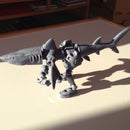Introduction: Camera Rig for 123D Catch
123D Catch is a new application and service from Autodesk that turns a series of photographs into a 3D model of an object or space.
The rig described here helps you structure the photos for best results. It lets you spin the camera around the object at a constant height and distance, while the object stays still. You can easily move the camera up and down to get top and bottom angles.
For this project, you will need:
Tools
3D printer
Saw
Electric screwdriver
Wood materials
3x 36" long 1" dia dowel
1x 12" long x 3/4" thick x 2" wide plank
1x 8" x 8" x 3/4" board
1x 6" x 6" x 3/4" board
Hardware
38x #8 3/4" construction screws
4x #8 3/4" hex bolt
1x #8 1" hex bolt
5x #8 wing nuts (6x optional)
2x #8 lock washers (3x optional)
1x 1/4" x 3/4" thumbscrew
1x 1/4 washer
2x casters (the base should not exceed 2" in depth)
Step 1: Print the Plastic Parts
You will need a 3D printer, such as a Makerbot, or access to one via a 3D printing bureau such as Shapeways or Ponoko. You will need to print:
1x l-brace
1x 3-brace
2x 2-brace
2x 1-brace
1x collar
1x flange
3x shaft collar
1x camera ring
1x camera platform
1x extension arm (optional)
Download the files and print them yourself, or send them to a service. They are also hosted on Thingiverse.
Attachments
Step 2: Cut Your Wooden Pieces to Size
Take one piece of dowel, and cut it into 2x 4" pieces, and 2x 8" pieces
Step 3: Attach L-brace to Base
Mark center of your 12" plank. Attach the L-brace to plank with 4x #8 screws.
Step 4: Assemble Bottom Brace
Place an 8" dowel in the middle of the 3-brace. Insert the 8" dowel into the top of the l-brace. Insert a 4" length of dowel on to the branches of the 3-brace. Fit a 1-brace onto the free end of the 4" dowels
Bring the 1-braces down to the plank by sliding the 3-brace down the longer length of dowel. Make sure the 4" dowels are tightly seated, into the 3-brace on one end, and a 1-brace on the other end.
Attach the 1-braces to the plank using 8x #8 screws. Secure the 4" dowels to the 1-brace and 3-brace by using 4x #8 screws (2 on each side).
Do NOT secure the 8" dowel yet. Its destiny lies elsewhere.
Step 5: Attach Casters
Attach the casters to the bottom of the plank using 8X #8 screws. Try not to hit the screws that hold the 1-brace in place from the other side.
Step 6: Prepare the Main Brace
Put a 2-brace on each end of one piece of 8" dowel (the one that is not in the base). Do not secure it with a screw yet.
Step 7: Assemble the Shaft Collars
Assemble the shaft collars by putting a #8 hex bolt through one side, and secure it with a #8 wing nut (do not tighten). The head of the hex bolt goes on the side with a matching hexagonal recess.
Step 8: Prepare the Main Boom
Attach the collar piece to the end of one of the 36" dowels. Put a shaft collar on the dowel with the collar, and slide it down towards the center
Step 9: Prepare Platform
Attach the flange to the 8" x 8" board using 4x #8 screws. Attach the other flange to the 6" x 6" board using 4x #8 screws
Step 10: Assemble Boom and Brace
Slide one end of the 8" dowel with the 2-braces over the other 8" dowel (in the 3-brace). Put a shaft collar on the dowel with the collar, and slide it down towards the center. Fit the long dowel with the collar through the other 2-brace and then through the bottom of the l-brace.
Ensure the 2-braces are lined up and secure them with 2x #8 screw
Step 11: Assemble the Base
Remove the 8" dowel from the 3-brace and place it in the flange, secure it with 1x #8 screw.
Put a shaft collar over the 8" dowel in the flange.
Step 12: Assemble Boom and Platform
Put the collar on the end of the long dowel over the short dowel in the flange.
Adjust the height of the shaft collar so that the long dowel is level.
Step 13: Connect Main Pole to Base
Place the other long dowel in the top of the 3-brace, threading it through the loose 2-brace. The main structure should be almost completely assembled.
Step 14: Finish Platform
Place the small platform (with flange) over the short dowel that is attached to the bottom plate
Step 15: Secure the Boom
Place a shaft collar on the outside of the long horizontal dowel. Tighten it down to secure the boom. Move the shaft collar that you placed on the boom earlier out, to secure the lower brace.
Step 16: Assemble Camera Adapter
Assemble the camera adapter by putting a #8 hex bolt through the two tabs, and secure it with a wing nut.
Attach the camera platform to the camera adapter with a "1 #8 hex bolt, placing a lock washer between the adapter ring and the platform. Secure with a wing nut.
Put a 1/4" thumbscrew in the bottom of the camera platform (the side with the raised ring) and tighten it.
Step 17: Place Camera Adapter on Pole
Put the camera adapter ring over the main pole (vertical dowel) and secure it by tightening the wing nut.
Step 18: Finished! Now, Use It to Take Some Pictures.
Congratulations! You have finished assembling the rig. Test it out by pushing the base back and forth, it should orbit smoothly around the platform.
Attach your camera to the camera platform by screwing the 1/4" thumbscrew into the tripod fixture in the bottom of the camera, securing it to the camera platform.
Loosen the wing nut that holds the platform and camera adapter ring, and adjust the camera until it is pointed right at the platform.
Place your target object on the platform, and take 30 or so evenly spaced pictures.
Loosen the wing nut on the camera adapter, and slide the whole camera mount up. Take another 20-30 pictures looking down at the platform.
Repeat, this time moving the camera mount down, so you can take pictures looking up at the platform.
You can adjust the vertical pole to move it farther or closer to the object, by loosening the two shaft collars and sliding the whole assembly on the boom.

Participated in the
Make It Real Challenge
























